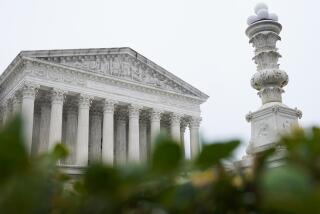Bush Aims to Ease Coeducation Rules for Public Schools
WASHINGTON — The Bush administration on Wednesday announced plans to relax restrictions on single-sex public schools and classrooms, effectively ending three decades of federal attempts to enforce a nationwide policy of coeducation.
New regulations drafted by the Department of Education will make it much easier to establish single-sex schools at taxpayer expense, and sweep away many of the legal obstacles to separate classes for girls and boys.
Only a few dozen of the 93,000 public schools in the country offer same-sex classes in mainstream academic subjects.
“We are not advocating single-sex schools, and we are not advocating single-sex classrooms,” said Ken Marcus, who oversees civil rights for the department. “We understand that coeducation remains the norm in American public education, and will continue to be the norm. We are simply trying to ensure that educators have flexibility to provide options.”
The new regulations, which are open to public comment for the next 45 days, change the way the department enforces Title IX of the 1972 education act, which prohibits sex discrimination in federally funded programs. Up until now, successive administrations have interpreted this provision to mean that virtually identical opportunities must be provided to students of both sexes.
According to the department, current regulations prohibit same-sex classes except in “very specific situations,” such as sexual education or physical education classes.
The proposed changes will permit single-sex classes as long as “they are part of an evenhanded effort to provide a range of diverse educational options for male and female students” or are designed to meet “particular, identified educational needs.”
The move could lead to “an explosion in the number of single-sex schools,” said Tom Carroll, who founded separate federally funded charter schools for boys and girls in Albany, N.Y., in 2002.
“It eliminates many of the legal clouds hanging over us.”
While it is fairly common for schools to offer separate-sex instruction in specific subjects, very few provide such classes across the entire curriculum.
One of the few that does is the Philadelphia High School for Girls, which sends almost all of its graduates to college.
“The environment itself, I think it empowers girls,” said Principal Geraldine Myles. “There is no ceiling to stop them from being anything they want to be, in terms of gender. It just isn’t there, and at their impressionable age, it probably makes a difference.”
Political opposition to single-sex education has dwindled sharply in recent years with Democratic senators such as Hillary Rodham Clinton of New York and Barbara A. Mikulski of Maryland joining Republicans such as Kay Bailey Hutchison of Texas in calling for greater freedom of choice. But some civil rights groups remain opposed to any relaxation of the Title IX requirements.
Single-sex education “perpetuates sex stereotypes and undermines workplace equality,” said Kim Gandy, president of the National Organization for Women. “It is much harder for men to accept women as equal partners in their workplaces if they have never been required to compete with them in school.”
Department of Education officials said the new rules were designed to offer parents the right to choose the kind of education they want for their children, rather than impose a new model of gender-segregated classrooms.
More to Read
Sign up for Essential California
The most important California stories and recommendations in your inbox every morning.
You may occasionally receive promotional content from the Los Angeles Times.










